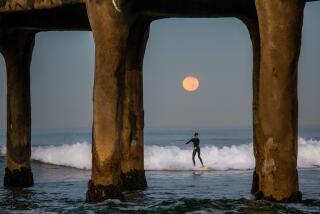Best Period for Catching Glimpse of Halley’s Comet Coming to an End
- Share via
The end of this week will be the “last chance of the best period” for viewing Halley’s Comet in the early morning sky.
By Sunday morning, the moon will illuminate the sky so much that the comet will be nearly impossible to find, according to Stephen J. Edberg, an astronomer with the Jet Propulsion Laboratory in Pasadena, who is also coordinator of amateur observations for the International Halley Watch.
“Friday morning will be the best time,” Edberg said. “Saturday will still be good, but Sunday is out.”
Edberg said the best viewing time will be between 4 a.m. and 5 a.m., from any darkened area that offers an unobstructed view of the southern horizon. A prime viewing spot is the desert, where the air is clear and there are no city lights.
“It’s easy to find it with the naked eye,” Edberg said. “It’s distinctly fuzzy, so it doesn’t look at all like a star, and it has a tail. Anybody ought to be able to see it.”
At 4:30 a.m., the comet’s position above the southern horizon should be about the width of a fist, held at arms length, he said.
Heading to Outer Reaches
Halley rounded the sun on Feb. 9 and is on its way back to the outer reaches of the solar system. It will pass the Earth closer on its outbound leg than it did coming in, and it will be only 39 million miles from the Earth on April 11. Even that is not very close, however, compared to some past visits by Halley, and it will be hard to see at that time from the Northern Hemisphere.
The moon will so illuminate the sky after this weekend that it will be virtually impossible to find the comet until around April 1, when it will again be visible but it will be even lower in the sky. For about two weeks, the comet will climb just above the horizon each night, which means the viewing time will be short and atmospheric interference will be the greatest.
After April 11, Halley will journey on out to somewhere between the planets Neptune and Pluto. The next time it comes back this way will be in the year 2061.
And according to astronomers, that won’t be a great year to see the comet either.
COMET WATCH
The Jet Propulsion Laboratory’s International Halley’s Comet Watch hot lines:
Inexperienced sky observers (818) 354-4300
Amateur astronomers (818) 354-4301
Griffith Observatory Sky Report (213) 663-8171
More to Read
Sign up for The Wild
We’ll help you find the best places to hike, bike and run, as well as the perfect silent spots for meditation and yoga.
You may occasionally receive promotional content from the Los Angeles Times.






